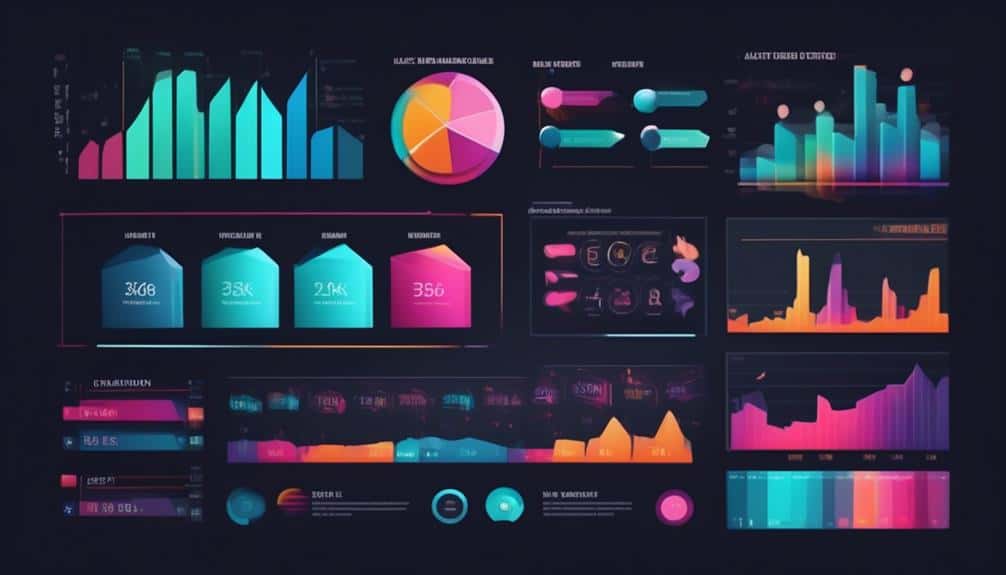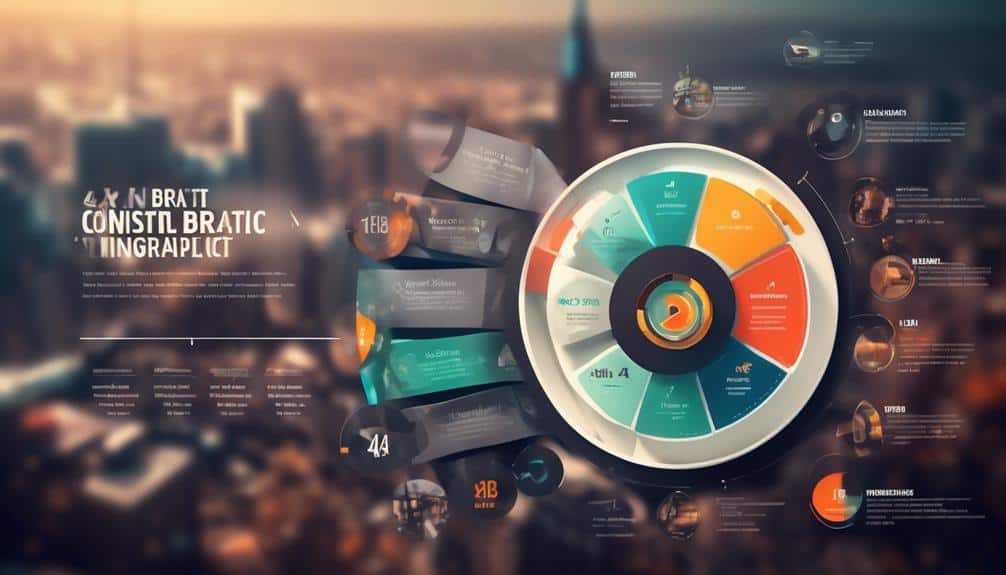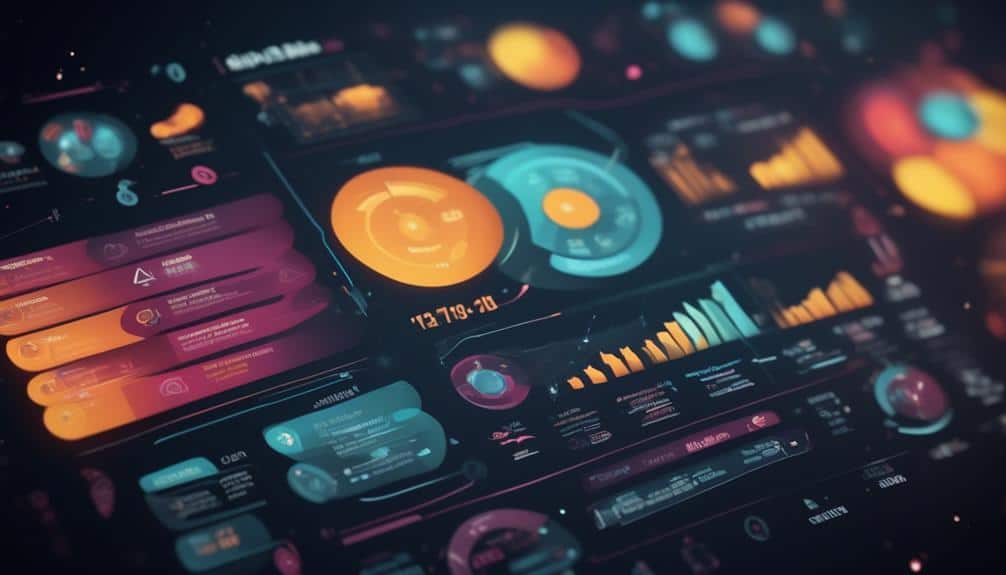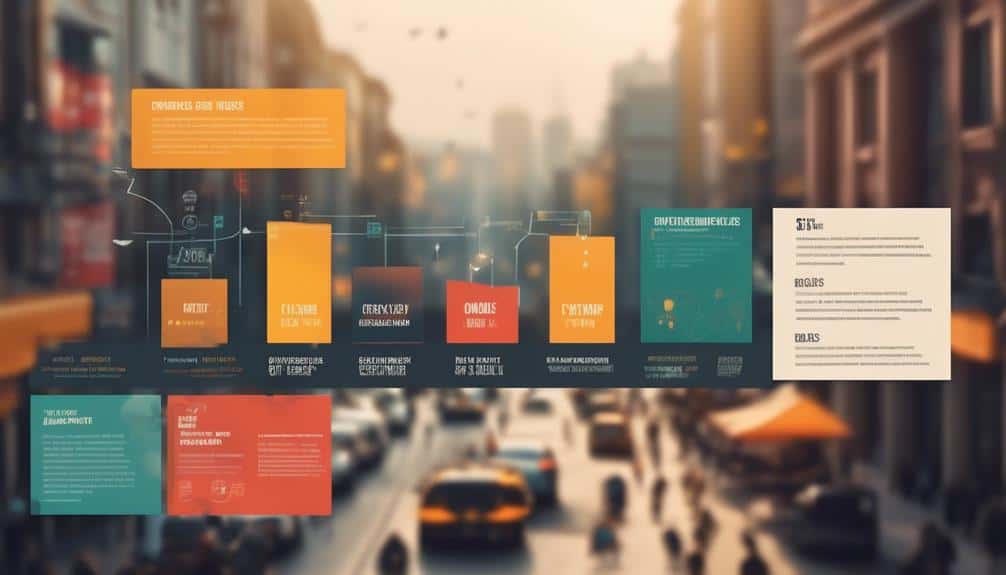The Anatomy of an Effective Infographic: Design Principles for Bloggers
When it comes to creating infographics for your blog, you might be thinking that design principles are too complex or time-consuming for you to master.
However, breaking down the anatomy of an effective infographic can provide you with valuable insights that go beyond just aesthetics.
By understanding key elements such as visual hierarchy, color psychology, and data visualization techniques, you can elevate your content to new heights.
Let's explore how these design principles can take your infographics from good to great and make your blog stand out in the crowded digital landscape.
Key Takeaways
- Utilize bold headlines, vibrant colors, and contrasting fonts to establish a clear visual hierarchy in the infographic design.
- Incorporate strategic color choices that align with the message to evoke emotions and enhance viewer engagement.
- Pair fonts for contrast and readability, ensuring they align with brand personality to create hierarchy and impact perception.
- Blend data with visuals using techniques like charts, graphs, and heatmaps to simplify complex information and enhance storytelling in the infographic.
Importance of Visual Hierarchy

To create a visually engaging infographic, mastering the importance of visual hierarchy is essential for effectively guiding your audience's attention. Visual impact plays a crucial role in capturing your audience's interest at first glance. By strategically organizing elements on your infographic, you can create a powerful visual impact that draws the eye and conveys information efficiently.
Graphic layout is key to establishing a clear visual hierarchy. Bold headlines, vibrant colors, and contrasting fonts can help prioritize information and lead the viewer through the content in a structured way. Utilizing size variations for text and graphics can also emphasize key points and create a dynamic flow for the reader.
When designing your infographic, consider the overall composition and how each element contributes to the visual hierarchy. Be intentional in your placement of elements to guide the viewer's eye seamlessly from one point to the next, ensuring a smooth and engaging experience. Mastering visual hierarchy won't only enhance the aesthetic appeal of your infographic but also improve its overall effectiveness in conveying information.
Color Psychology in Infographics
Picture this: the colors you choose for your infographic can speak volumes without saying a word. Colors have the power to evoke emotions, create strong connections, and influence how viewers perceive your message.
Harness the psychology of colors to enhance the impact and effectiveness of your infographic design.
Impact of Colors
Color psychology plays a vital role in infographics, influencing how viewers interpret and engage with the information presented. When creating your infographic, remember that color contrast is key to making important elements stand out. Bold, contrasting colors can draw attention to key points and help guide the viewer's eye through the content.
Additionally, maintaining color balance is crucial for a harmonious and visually appealing design. Too much of one color can overwhelm, while a well-balanced palette can enhance readability and overall impact. Experiment with different color combinations to find what works best for your infographic, ensuring that the colors you choose align with the message you want to convey.
Emotional Connections
As you craft your infographic design, harnessing the power of color psychology can forge strong emotional connections with your audience, elevating the impact of your visual storytelling.
- Color Psychology: Utilize warm colors like red and orange for passion or excitement, or cool colors like blue and green for calmness and trust.
- Contrast for Emphasis: Use contrasting colors to highlight key information and evoke strong emotions within your audience.
- Brand Consistency: Maintain a consistent color palette with your brand's identity to reinforce brand recognition and create a cohesive emotional experience for your audience.
Viewer Perception
To captivate your audience with your infographic, strategically weave colors that resonate with their emotions and perceptions, enhancing the overall impact of your visual narrative. Color plays a crucial role in influencing cognitive load and visual perception.
Bright and contrasting hues can draw attention to key points, making information easier to process and remember. For instance, using warm tones like red and orange for important data can evoke urgency and excitement, while cool tones such as blue and green can convey calmness and trustworthiness.
Choosing the Right Fonts
When selecting fonts for your infographic, consider the readability and visual appeal they offer to enhance the overall impact of your design.
- Font Pairing:
- Mix serif and sans-serif fonts for contrast.
- Ensure the fonts complement each other in style and size.
- Readability Techniques:
- Use legible fonts, especially for small text.
- Adjust line spacing and kerning for better readability.
- Visual Appeal:
- Choose fonts that align with your brand's personality.
- Experiment with different font weights to create hierarchy.
Selecting the right fonts can make a significant difference in how your infographic is perceived. Opting for a font pairing that balances readability with visual appeal can captivate your audience and make the information easier to digest.
Data Visualization Techniques

With the right data visualization techniques, your infographic can transform from a mere design into a compelling story that captivates your audience. Data interpretation is key in presenting information clearly. Incorporating effective graphic design ensures that your data is not only understood but also engages your readers visually. Here are some techniques to consider:
| Data Visualization Techniques | Description | Example |
|---|---|---|
| Infographics | Blend data with visuals | Comparing sales data with colorful charts |
| Charts and Graphs | Simplify complex data | Displaying trends using line graphs |
| Heatmaps | Highlight patterns | Showing website activity with color gradients |
Maximizing White Space
Maximize the impact of your infographic by strategically utilizing white space to enhance visual clarity and draw attention to key elements. When it comes to maximizing white space, consider the following:
- Negative Space Utilization
- Embrace the power of negative space to create a visual hierarchy that guides the viewer's eye through the infographic.
- Use ample white space around important information to make it stand out and improve overall readability.
- Visual Balance Techniques
- Experiment with symmetrical and asymmetrical layouts to find the right balance that complements your infographic's message.
- Ensure that white space is distributed evenly throughout the design to avoid overwhelming the viewer with too much information at once.
Incorporating Brand Elements

When incorporating brand elements into your infographic, think about integrating your brand colors seamlessly, strategically placing your logo for maximum impact, and selecting typography that aligns with your brand's identity.
Your brand's visual elements should harmonize with the overall design, enhancing recognition and reinforcing brand association effortlessly.
Pay attention to these details to create a cohesive and memorable infographic that resonates with your audience.
Brand Colors Integration
To infuse your brand's identity seamlessly into your infographic, consider integrating your brand colors strategically throughout the design.
- Color Harmony: Blend your brand colors harmoniously to create a visually appealing infographic.
- Mix primary and secondary brand colors for a balanced look.
- Use color psychology to evoke the desired emotions in your audience.
- Experiment with different shades and tints to add depth to your color palette.
Logo Placement Strategies
For optimal brand recognition and cohesiveness in your infographic, strategically placing your logo and other brand elements is pivotal. Logo visibility plays a crucial role in enhancing brand recognition, so ensure your logo is prominently featured in your infographic. Strategic logo positioning not only reinforces brand identity but also helps in creating a lasting impression on your audience. Consider incorporating your logo in a way that is visually appealing and seamlessly integrated into the overall design. Below is a table to illustrate different logo placement strategies that you can consider for your infographic:
| Logo Placement Strategies | Description |
|---|---|
| Top Center | Establishes brand authority |
| Bottom Right | Creates balance in design |
| Background Watermark | Adds subtle branding element |
| Overlay on Images | Integrates logo creatively |
| Corner Emblem | Provides consistent brand presence |
Typography for Brand
How can you infuse your brand identity into your infographic through the strategic use of typography? When it comes to typography for brand, incorporating brand elements is key in achieving brand recognition.
Here are some tips to help you make the most of your typography:
- Typography Consistency: Ensure that the fonts you use align with your brand's overall style and messaging.
- Consistent font choices help establish a recognizable brand identity.
- Brand Recognition: Incorporate elements like your brand's colors and logo into your typography to strengthen brand recognition.
- Use colors that are consistent with your brand's color palette to create a cohesive look.
- Creative Typography: Experiment with different font styles and sizes to add visual interest while staying true to your brand's voice.
- Play with hierarchy to emphasize important information and maintain a visually appealing layout.
Storytelling Through Infographics

Crafting an engaging narrative within your infographic is key to captivating your audience and conveying information effectively. Visual storytelling is a powerful tool that allows you to take your audience on a journey through your content. Start by outlining the key points you want to communicate and then think about how you can visually represent each idea. Use engaging graphics that not only enhance the aesthetic appeal but also serve a purpose in telling your story. Incorporating a cohesive color scheme and consistent design elements will help tie everything together and create a seamless flow of information.
Consider the layout of your infographic as well. Arrange your content in a way that guides the viewer from one point to the next, creating a logical progression that keeps them engaged. Remember, every element in your infographic should contribute to the overall story you're trying to tell. By focusing on visual storytelling and using engaging graphics, you can create infographics that not only inform but also captivate your audience.
Mobile-Friendly Design Tips
When optimizing your infographic for mobile viewing, ensure that your design remains visually impactful and user-friendly across various screen sizes. To make your infographic accessible and usable on mobile devices, consider the following mobile-friendly design tips:
- Responsive Design: Utilize responsive design techniques to ensure your infographic adapts seamlessly to different screen sizes, maintaining its clarity and readability.
- User Experience: Prioritize user experience by simplifying navigation, using intuitive gestures, and optimizing loading times for a seamless mobile interaction.
- Visual Hierarchy: Maintain a clear visual hierarchy by prioritizing key information and using concise text to ensure your message is easily digestible on smaller screens.
Call-to-Action Best Practices

To maximize engagement and drive desired actions from your audience, ensure your call-to-action is clear, compelling, and strategically placed within your content. When it comes to conversion optimization, your call-to-action is the key to turning engaging content into tangible results. Make sure your CTA stands out visually, whether it's through contrasting colors, bold fonts, or eye-catching graphics. Keep your language simple and direct, prompting users to take the next step without confusion.
Consider the placement of your call-to-action carefully. It should be strategically positioned where readers are most likely to notice it, such as at the end of a blog post or alongside relevant information. By making your CTA easily accessible, you increase the chances of converting passive readers into active participants. Don't forget to test different variations to see what works best for your audience. Remember, a well-crafted call-to-action can be the difference between a reader simply consuming your content and them taking the desired action you want them to.
Infographic Distribution Strategies
Ensure your captivating infographic reaches its full potential by strategically sharing it across various platforms and channels. When it comes to infographic sharing, the right distribution strategies can turn your content into viral material. Here are some creative ways to make sure your infographic gets the attention it deserves:
- Leverage Social Media: Share your infographic on platforms like Instagram, Twitter, and LinkedIn to reach a wider audience and engage with followers.
- Collaborate with Influencers: Partnering with influencers in your niche can help amplify your infographic's reach and increase its chances of going viral.
- Submit to Infographic Directories: Explore websites that specialize in hosting infographics to increase visibility and attract viewers interested in your content.
Frequently Asked Questions
How Can Infographics Be Optimized for Search Engine Visibility?
To boost search engine visibility for infographics, optimize images with relevant keywords for SEO. Build links to your site through sharing and engaging content. Enhance user engagement with visually appealing and informative graphics.
What Are Some Common Mistakes to Avoid When Creating Infographics?
When creating infographics, avoid common mistakes like poor color contrast and font choice. Your design should be visually appealing and easy to read. Don't let these missteps distract from effectively conveying your message.
How Do You Ensure the Accuracy and Credibility of Data Presented in an Infographic?
To ensure accuracy in your infographic, verify data from reliable sources. Maintain credibility by citing references transparently. Double-check numbers and facts. Use charts and graphs clearly. Present info with honesty and precision for a trustworthy infographic.
Are There Any Legal Considerations to Keep in Mind When Using Images or Data in an Infographic?
When using images or data in an infographic, it's crucial to respect copyright laws. Always ensure proper image sourcing to stay legally compliant and protect your content. Be creative, but also mindful of the law.
How Can Infographics Be Effectively Integrated Into a Social Media Marketing Strategy?
To boost social media impact, infographics must captivate. Engage viewers with compelling stories, enhancing brand visibility. Infographic engagement drives brand awareness, connecting you with your audience on a visual level. Stand out!
Conclusion
Now that you've mastered the art of infographic design, your blog posts are sure to stand out and captivate your audience. Remember to prioritize visual hierarchy, choose colors wisely, and tell a compelling story through your data.
Utilize white space effectively, optimize for mobile, and always include a strong call-to-action. With these principles in mind, your infographics won't only be visually stunning but also highly effective in conveying your message.
Happy designing!








